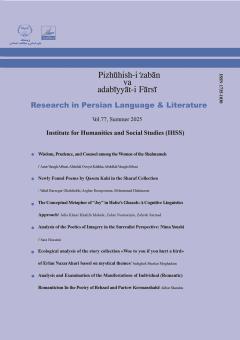About the journal
Pazhūhish-i Źabān va Adabiyyāt-i Farsī
Recent Articles
-
Open Access Article
1 - Wisdom, Prudence, and Counsel among the Women of the Shahnameh
Amir Vasegh abbasi ، abdolali oveisi kahkha * ، abdollah vasegh abbasiIssue 77 , Vol. 23 , Summer 2025 -
Open Access Article
2 - Newly Found Poems by Qasem Kahi in the Sharaf Collection
vahid bargegar ghahfarrokhi ، asghar rezapurian * ، mohammad hakimazarIssue 77 , Vol. 23 , Summer 2025 -
Open Access Article
3 - The Conceptual Metaphor of “Joy” in Hafez’s Ghazals: A Cognitive Linguistics Approach
julia khani khalife mahalle ، zohre nouraeenia * ، zohreh sarmadIssue 77 , Vol. 23 , Summer 2025 -
Open Access Article
4 - Analysis of the Poetics of Imagery in the Surrealist Perspective: Nima Youshij
sara hosseini *Issue 77 , Vol. 23 , Summer 2025 -
Open Access Article
5 - Ecological analysis of the story collection «Woe to you if you hurt a bird» of Erfan NazarAhari based on mystical themes
Sedigheh Sherkat Moghadam *Issue 77 , Vol. 23 , Summer 2025 -
Open Access Article
6 - Analysis and Examination of the Manifestations of Individual (Romantic) Romanticism In the Poetry of Behzad and Partow Kermanshahi
akbar shamloo *Issue 77 , Vol. 23 , Summer 2025
Most Viewed Articles
-
Open Access Article
1 - Analysis of Asynartete capacities and ways of its creation in Persian poetry
یحیی عطائی *Issue 52 , Vol. 17 , Spring 2020 -
Open Access Article
2 - A study of the content and structure of interpretation in the spiritual Masnavi
Maryam Nafeli Shahrestani * ، hosein aghahoseiniIssue 60 , Vol. 19 , Spring 2021 -
Open Access Article
3 - Classification of the Kramat of Olia
Mohammad RoodgarIssue 60 , Vol. 19 , Spring 2021 -
Open Access Article
4 - Analysis of the effect of short words of Nahj al-Balaghah in Persian literature (with emphasis on the wisdom of 142 Nahj al-Balaghah, citing verses of the Quran)
Fakhrieh Namazian ، Jalil Tajlil * ، Ruqayyah SadraieIssue 60 , Vol. 19 , Spring 2021 -
Open Access Article
5 - mythical places in folktales
Sara Chalak *Issue 60 , Vol. 19 , Spring 2021 -
Open Access Article
6 - The"Avaze koshtegan"(The song of the slain), from the view of the Critical Theory of the Frankfurt School, with Emphasis on the Theories of Herbert Marcuse Critique of Modern Society in the Novel of the
Mahnaz Fooladi * ، maryam hoseiniIssue 60 , Vol. 19 , Spring 2021 -
Open Access Article
7 - Effective Factors in Formation of the Philosophical Formation of the Literary Genre in Romanticism
Hamid Forghani ، Ahmad رضاييجمكرانيIssue 51 , Vol. 16 , Winter 2019 -
Open Access Article
8 - The Effect of Symbolism of Expression Methods of Nima Yushij Thoughts
حاتم قادری ، A m ، Mohammad kamalizadehIssue 27 , Vol. 10 , Winter 2013 -
Open Access Article
9 - Analysis and Comparison of Prophet Mohammad's Praise and Ascension in Attar's Four Massnavi Books (Elahi-Nameh, Assrar-Nameh, Manteq Al Tair & Mosibat-Nameh)
Ahmad رضاييجمكرانيIssue 9 , Vol. 5 , Autumn_Winter 2007 -
Open Access Article
10 - A Critical Review and Analysis of the Narrative Technique in a Story of the Golestan of Saadi
طیبه پرتویراد * ، mostafa gorjiIssue 38 , Vol. 13 , Autumn 2015






